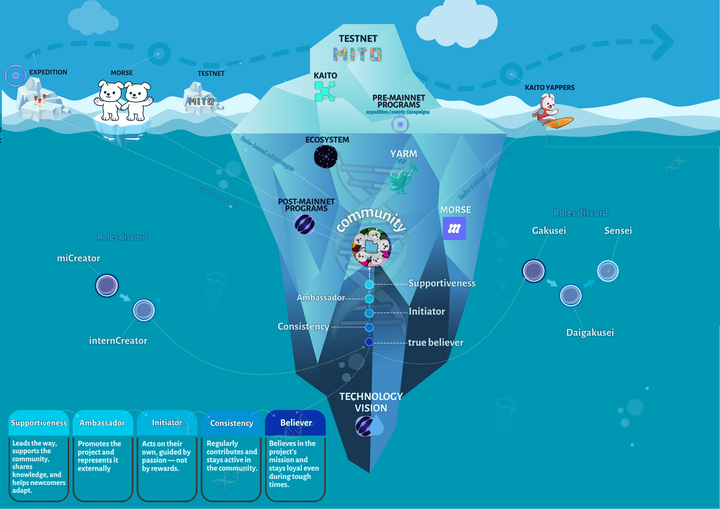Kaito Yap Rush: Revolutionizing Crypto Engagement with Project-Specific Rewards and Future Trends
The cryptocurrency ecosystem is no stranger to innovation, and Kaito AI’s Yaps program has emerged as a transformative force in how users engage with and contribute to the Web3 space.
Launched in December 2024, the Kaito Yaps program introduces a novel "Yap-to-Earn" model that rewards users for sharing high-quality, crypto-related content on the X platform. The "Kaito Yap Rush" refers to the surge in user participation driven by the promise of project-specific rewards, including potential airdrops, and the broader implications for user behavior in the crypto community.
This article explores the mechanics of project-specific Yap rewards, how they are reshaping user behavior, and predictions for their impact on the future of the crypto information ecosystem. It draws on insights from various sources to provide a comprehensive analysis.
Understanding the Kaito Yap Rush
Kaito AI, founded in 2022 by Yu Hu, a former Citadel quantitative trader, is an AI-powered platform designed to address the fragmentation of crypto information. By indexing thousands of Web3 sources , such as X posts, governance forums, podcasts, and research papers, Kaito delivers real-time, actionable insights to users. The Yaps program, a flagship initiative, gamifies community engagement by rewarding users with Yap points for creating and sharing valuable crypto content on X.
Unlike traditional social media metrics that prioritize likes or follower counts, Kaito’s AI-driven Proof-of-Attention model evaluates content based on three key dimensions: volume (frequency of relevant posts), engagement (reputation-weighted interactions), and semantics (originality and insightfulness of content).
The "Yap Rush" refers to the rapid adoption of this program, fueled by its promise of rewards, including weekly payouts and potential airdrops. In February 2025, Kaito launched its $KAITO token, allocating 10% of its 1 billion token supply to early community members, with an additional 7.5% reserved for long-term creator incentives. The excitement around these rewards, coupled with project-specific leaderboards, has driven significant user engagement, with over 250,000 users participating by January 2025.
Project-Specific Yap Rewards
A key feature of the Yaps program is its project-specific leaderboards, which track user contributions to the "mindshare" of particular crypto projects, such as Berachain, Monad, Eclipse, and MegaETH. These leaderboards are distinct from the general Crypto Twitter (CT) or Crypto x AI leaderboards, as they focus on contributions to individual projects, rewarding users who demonstrate loyalty and high-quality engagement. Projects leverage these leaderboards to identify key opinion leaders (KOLs) and supporters, offering incentives such as airdrops, whitelist spots, or direct financial rewards. For instance, Berachain airdropped tokens to Kaito Yappers, and other projects like Story Protocol and Movement Labs have integrated Yap points into their incentive programs.
The Yapper Launchpad, a community-driven platform, allows users to vote on which projects receive dedicated leaderboards, using their Yap points or "Smart Follower" status. This democratic approach ensures that community interest drives attention allocation, creating a dynamic ecosystem where both pre-token generation event (TGE) and post-TGE projects can engage users. The Rewards Station, introduced on March 28, 2025, further enhances this system by distributing $5,000 in $sKAITO tokens weekly to the top 50 Yappers and Emerging Yappers, fostering a competitive yet merit-based environment.
These project-specific rewards create a flywheel effect: users are incentivized to produce high-quality content, which increases project visibility, attracting more engagement and further rewarding contributors. This model not only benefits creators but also helps projects build stronger communities and achieve efficient marketing.
Expected Changes in Crypto User Behavior Patterns
The Kaito Yap Rush is reshaping how crypto users interact with the ecosystem, moving away from traditional engagement metrics toward a more value-driven approach. Several behavioral shifts are evident:
- Focus on Quality Over Quantity: Kaito’s AI algorithms prioritize insightful, original content over spammy or repetitive posts. Users are discouraged from flooding X with low-effort content, as the system filters out buzzword-heavy or plagiarized posts. This shift encourages users to invest in research and produce thoughtful analyses, elevating the overall quality of crypto discourse.
- Niche Specialization: To maximize Yap earnings, users are increasingly focusing on specific crypto niches, such as DeFi, AI, or layer-1 protocols like Polkadot or MegaETH. By specializing, users can build authority and attract engagement from "Smart Followers"—influential accounts whose interactions carry more weight in Kaito’s scoring system. This trend fosters deeper expertise and more targeted communities.
- Strategic Engagement: Users are adopting a "reply guy" strategy, engaging with 100+ relevant posts daily to build visibility and connections. Thoughtful replies to influential accounts are more effective than standalone posts for new Yappers, as they leverage the reputation of established voices. This behavior promotes meaningful interactions and reduces reliance on vanity metrics.
- Community-Driven Influence: The Yapper Launchpad and Kaito Connect empower users to shape the ecosystem by voting on projects and participating in governance-like activities. This decentralization of influence encourages users to align with projects they believe in, fostering a sense of ownership and community.
- Monetization of Attention: The Yap-to-Earn model transforms attention into a quantifiable asset, with some users reporting earnings of up to $1,178 for their Yaps through project-specific rewards or direct sales. This financial incentive is driving increased participation, particularly among smaller accounts that can compete without large followings.
These shifts indicate a move toward a more meritocratic and transparent crypto community, where influence is earned through genuine contributions rather than manipulated metrics.
Future Predictions for the Kaito Yap Ecosystem
Looking ahead, the Kaito Yap Rush is poised to have a lasting impact on the crypto space, with several predictions for its evolution:
- Sustained Growth in User Participation: With the promise of future airdrops and the success of the February 2025 $KAITO token launch, user adoption is likely to continue growing. The allocation of 7.5% of the token supply for long-term creator incentives suggests ongoing opportunities for Yappers, potentially attracting millions of users by 2026.
- Integration with Broader Web3 Ecosystems: As Kaito expands its InfoFi network through Kaito Connect, Yaps could evolve into a tradable or tokenized asset, enabling new monetization models such as governance rights or staking opportunities. This would further embed Kaito in the Web3 economy, making it a critical infrastructure for information markets.
- Challenges to Sustainability: Critics, such as KOL @Xiao Xiong Bing Gan.eth, argue that the Yaps program may face challenges if the voting mechanism for project leaderboards becomes a mere queue for launches, reducing competitive dynamics. Additionally, the algorithm’s bias toward established KOLs could discourage retail investors, potentially limiting long-term engagement. Kaito will need to address these concerns to maintain momentum.
- Enhanced AI Capabilities: Kaito plans to deploy regional large language models (LLMs) to better capture cultural nuances, ensuring fair evaluation of non-English content. This could broaden the program’s global reach, making it more inclusive and accessible to diverse crypto communities.
- Redefining the Attention Economy: By prioritizing quality and authenticity, Kaito is setting a new standard for how attention is valued in crypto. This could inspire other platforms to adopt similar AI-driven reward systems, fundamentally reshaping social interaction in Web3.
Conclusion
The Kaito Yap Rush represents a paradigm shift in the crypto ecosystem, leveraging AI to reward meaningful contributions and foster community-driven growth. Project-specific Yap rewards incentivize high-quality content creation, while the Yapper Launchpad and Rewards Station empower users to shape the ecosystem. These mechanisms are driving behavioral changes, encouraging specialization, strategic engagement, and a focus on value over volume. Looking forward, Kaito’s innovative approach could redefine the attention economy, though it must navigate challenges to ensure sustainability. As the platform evolves, it stands to play a pivotal role in how crypto information is shared, valued, and rewarded, offering a glimpse into the future of Web3 engagement.
References
- https://faq.yaps.kaito.ai
- https://www.coingecko.com
- https://growkaito.com
- https://www.bitrue.com
- Kaito AI Airdrop.
- Bitget News.
- BitPinas.
MITOSIS Official links
GLOSSARY
Mitosis University
WEBSITE
X (Formerly Twitter)
DISCORD
DOCS



Comments ()